|
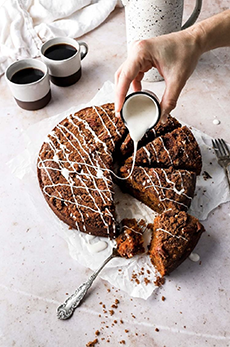
[1] Cinnamon Swirl Pumpkin Coffee Cake: pouring on the glaze (photos #1 and #2 © Baran Bakery.)
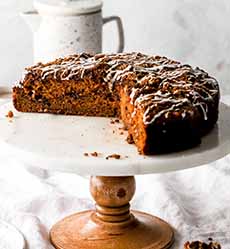
[2] The inside is studded with pecans.
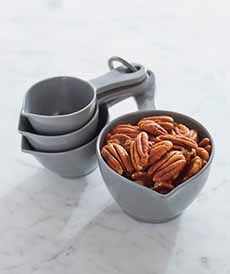
[3] Buy the freshest whole pecans and chop them (photo © Williams Sonoma).
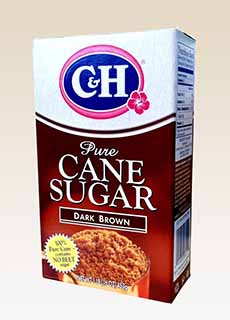
[4] Top quality dark brown sugar (photos #4 and #9 © C & H Sugar).
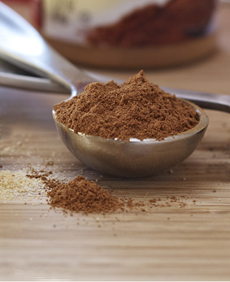
[5] Cinnamon, ground from cinnamon sticks (photo #9—photos #5 and #6 © McCormick).
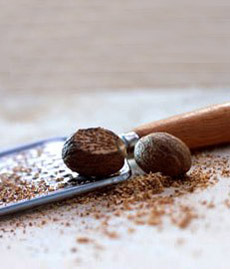
[6] You’ll get much better flavor by grating a nut rather than purchasing ground nutmeg.
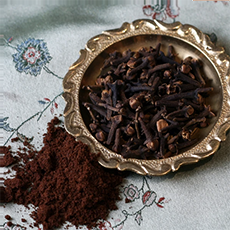
[7] Whole and ground cloves. For baking, you need ground cloves (photo © Silk Road Spices).
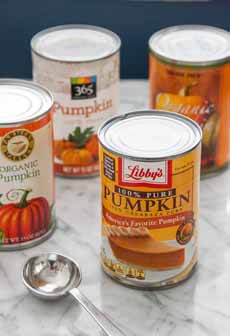
[8] Pumpkin puree. Be sure to purchase purée and not pumpkin pie filling. Here’s a review of 7 brands (photo © The Kitchn).
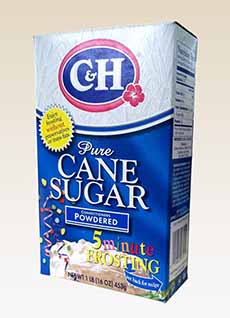
[9] Turn powdered sugar, milk, and vanilla bean paste into the glaze.
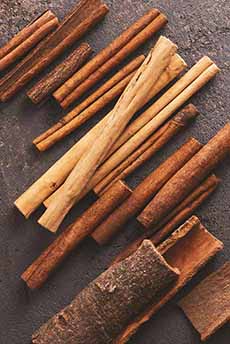
[10] The four basic types of cinnamon sticks, from top to bottom: Vietnamese/Saigon, Ceylon, Indonesian/Korintje, Chinese (photo © Alina Kholopova | Alamy).
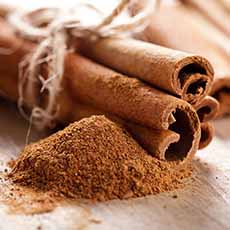
[11] Cassia cinnamon (photo © American Heritage Chocolate).
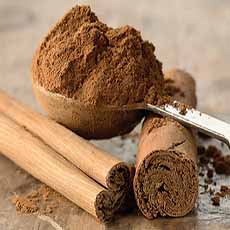
[12] Vietnamese (Saigon) cinnamon sticks (photo © King Arthur Baking).
|
|
On weekends, we make time to test a new baking recipe. We call it our “weekend baking project,” and friends who are out and about on Sundays know they can stop by for a slice.
This weekend we made a delicious Cinnamon Swirl Pumpkin Coffee Cake with the recipe below (photos #1 and #2).
The recipe was developed by Bernice Baran of Baran Bakery and sent to us by C&H Sugar. The recipe combines canned pumpkin, brown sugar, cinnamon, and pecans to create a rich, seasonal coffee cake that will have everyone asking for seconds.
If you want to turn it into a dessert, make it à la mode with vanilla ice cream and caramel or butterscotch sauce (see the difference between caramel and butterscotch in the footnote* below*).
Check out more wonderful recipes at BaranBakery.com, and enjoy Bernice’s beautiful food photography.
> The history of coffee cake.
> The history of cake.
> The history of cinnamon is below.
> The history of pumpkins.
> The different types of cake: a glossary.
> The different types of sugar: a glossary.
RECIPE: CINNAMON SWIRL PUMPKIN COFFEE CAKE
Prep time is 10 minutes, and cook time is 45-50 minutes.
Ingredients For A 10-Inch Cake
For The Cinnamon Swirl
1 cup pecans, chopped
1 cup dark brown sugar
1 tablespoon cinnamon
1/8 teaspoon salt
For The Pumpkin Cake
2 cups all-purpose flour, leveled
1 teaspoon baking soda
2 teaspoons baking powder
1/2 teaspoon salt
2 teaspoons cinnamon
1 teaspoon nutmeg
1 teaspoon cloves
1 teaspoon ginger
4 large eggs, room temperature
1-1/2 cups packed dark brown sugar
3/4 cup vegetable oil
1 can (15 ounces) pumpkin purée
1 teaspoon vanilla
For The Glaze
1 cup powdered sugar
2 tablespoons milk
1/2 teaspoon vanilla bean paste†
Preparation
1. MAKE the cake. Preheat the oven to 350°F (177°C) and grease a 10-inch springform pan.
2. COMBINE all the ingredients for the cinnamon swirl in a medium bowl and set them aside. In another medium bowl…
3. WHISK together the dry ingredients—flour, baking soda, baking powder, salt, and spices—and set them aside. In a large bowl…
4. WHISK together the eggs, dark brown sugar, oil, pumpkin purée, and vanilla extract until the mixture is completely smooth.
5. ADD the dry ingredients to the wet and whisk just until the last streak of flour is combined.
6. POUR half of the batter into the prepared pan, top with half of the cinnamon swirl filling, repeat with the rest of the batter, and top with the second half of the streusel.
7. BAKE the coffee cake for about 40-50 minutes, until it springs back when you press on it.
8. COOL the cake in the pan for at least 30 minutes before removing. While the cake is cooling…
9. COMBINE all the ingredients for the glaze and mix until smooth. When the cake is finished cooling, pour the glaze over the cake and serve.
Any leftovers can be frozen, wrapped tightly in plastic. (Additionally, we put the wrapped plastic cake or slices into a freezer bag.)
THE HISTORY OF CINNAMON
Cinnamon was one of the earliest spices to be traded globally (and remember, only the wealthy could afford imported spices).
Initially, much of the world’s cinnamon came from China, an established trading partner.
B.C.E. There is 3000-year-old evidence of cinnamon trading, found during excavations in Tel Dor, Israel. This suggests not only trade in cinnamon but long-range spice trade in general, from the Far East westward [source].
In ancient Egypt, the spice was revered for its fragrance and used for embalming and religious practices. It was once more valuable than gold [source].
The Romans used cinnamon less as a culinary spice, but as a sacred incense, and burning it at funerals.
13th century (approximate). In medieval Europe, cinnamon was a favorite flavoring at banquets of the wealthy. It was also used as an appetite stimulant, a digestive, an aphrodisiac, a treatment for coughs and sore throats, and in religious rites.
For global traders like the Dutch and the Portuguese, spices were considered the most important merchandise; cinnamon was the most important of them all. It was the most profitable product for the Dutch East India Trade Company. [source].
15th century. Because cinnamon was one of the first spices sought by 15th-century European explorers, some say it indirectly led to the discovery of America [source].
16th to 18th centuries. The Dutch and Portuguese brutally fought to control the cinnamon plantations of Ceylon (now Sri Lanka) [source].
21st century. As of 2019, the countries that produce most of the world’s cinnamon are China (50%), Indonesia (28%), Vietnam (13%), and Sri Lanka (8%) source.
What Exactly Is Cinnamon?
Cinnamon is the dried inner bark of various evergreen tree species belonging to the genus Cinnamomum. That botanical name derives from the Hebraic and Arabic word “amomon,” meaning “fragrant spice plant.”
There are different varieties of culinary cinnamon, and except for Ceylon cinnamon, they are referred to as cassia (here’s the difference).
Botanically, cinnamon is a member of the Lauraceae (laurel) family (which also includes avocados and bay leaves). There are more than 250 plant species in the Cinnamomum verum genus, with only four important as culinary cinnamon:
Ceylon Cinnamon, also known as True Cinnamon (Cinnamomum verum) and Sri Lankan Cinnamon (Cinnamomum zeylanicum), primarily grown in Sri Lanka (Ceylon is the old British colonial name) but also in Southern India and Madagascar.
Ceylon cinnamon sticks are multilayered, a roll of numerous thin and fragile sheets of bark. The flavor is delicate and mildly sweet, with a soft aroma. The color is yellowish-tan (see photo #10). It’s the most expensive cinnamon.
Ceylon cinnamon is often considered the only “true” cinnamon, with all other types referred to as cassia. However, all four species listed here are botanically classified as cinnamon. Only one is Cinnamomum verum (true cinnamon). The word cassia came to Old English from Latin, probably denoting the wild cinnamon, via Greek from the Hebrew qĕṣī‘āh.
Chinese Cinnamon (Cinnamomum cassia and Cinnamomum aromaticum), produced in China and Vietnam. Chinese cinnamon is often sold as chunks of bark rather than in sticks (quills). The bark is thicker than other varieties and it is the darkest color, a gray-brown (see photo #10). You can find it in the form of twigs that have been sliced into small segments. They often have an outer “skin” that resembles tree bark.
While cinnamon is used more for baking and desserts in Western cuisines, it is much more common in savory cooking in Asian cuisines. In ancient China, it was primarily valued for spicing and preserving jerky. In contemporary cuisine, it is used in braises, stir-fries, and stews. The whole pieces are typically added to the recipe, to deliver a more subtle flavor than using ground powder [source].
Chinese cinnamon is also one of the main ingredients in Five Spice Powder.
Indonesian Cinnamon (a.k.a. Korintje cinnamon), Cinnamomum burmannii, Cassia vera, is grown on the Indonesian island of Sumatra, which produces the most cinnamon in the world [source]. Both Vietnamese cinnamon and Indonesian sticks comprise a thick single layer of rough bark, less prone to breakage than Ceylon cinnamon. The color is reddish brown. The flavor is strong and spicy and the aroma is pungent. Unlike Ceylon cinnamon, the stick is difficult to break, which is why you might prefer to purchase it in ground form (but great as a garnish for hot chocolate or mulled cider). Korintje cinnamon is the industry standard for bakers, chefs, and home cooks in the U.S., delivering quality at an affordable price.
Vietnamese or Saigon Cinnamon, Cinnamomum loureirii, primarily grown in Vietnam but also in Southern China and Laos. Vietnamese cinnamon and Indonesian sticks tend to be a single thick layer and less prone to breakage; the flavor is strong and spicy and the aroma is pungent. The color is reddish brown (see photo #10). Unlike Ceylon cinnamon, the stick is difficult to break.
How Cinnamon Is Processed
At harvest, the outer bark of the tree is scraped off and then the inner bark is stripped and laid in the sun to dry.
The bark then curls into cylindrical rolls or “quills” (except for Chinese cinnamon), after which it is cut into sticks.
With Ceylon cinnamon, pieces of the bark are then removed and placed inside one another to form the quills (photo #10, long light tan quills second from top).
Indonesian and Vietnamese cinnamon dry in one thick quill (photo #10, top and second to bottom).
Chinese cinnamon dries in chunks (pieces) of bark (photo #10, bottom.
When you purchase cinnamon, the jar may or may not state the origin. But if you’re buying sticks, you can now eyeball them and take a guess!
________________
*The difference between the butterscotch and caramel: Caramel is made with granulated sugar while butterscotch is made with brown sugar. Table sugar (white sugar) is heated and melted until it’s browned. It can be thinned with water, cream, or milk. As its name indicates, butterscotch is made with butter (but no Scotch!). Brown sugar and butter are melted together and cooked, then cream is added. A pinch of salt is added to both caramel and butterscotch. While there is no definitive etymology of the the “scotch” portion of the word, one theory is that “scotch” is a corruption of “scorch,” referring to the melting of the sugar and butter.
†Vanilla bean paste is valuable in a glaze or whenever you don’t want to water down a preparation by using vanilla extract. However, you can substitute an equal amount of vanilla extract or vanilla powder.
|














